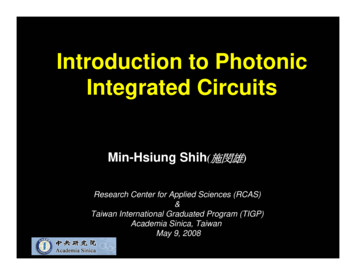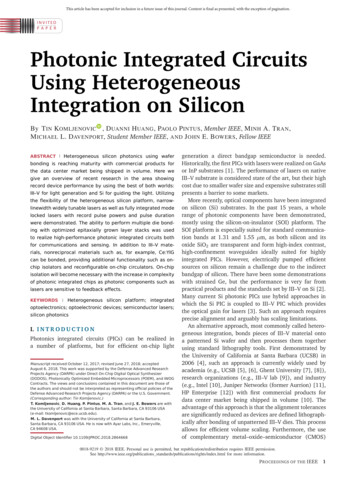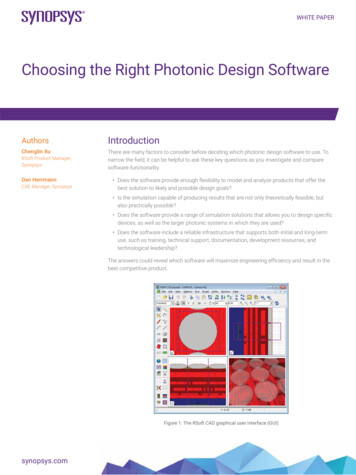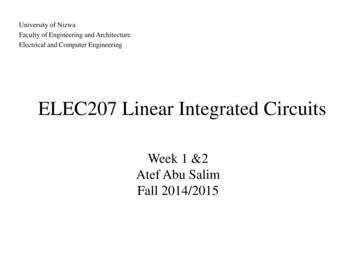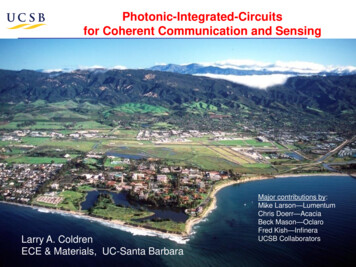
Transcription
Photonic-Integrated-Circuitsfor Coherent Communication and Sensing Boston ULarry A. ColdrenECE & Materials, UC-Santa BarbaraMajor contributions by:Mike Larson—LumentumChris Doerr—AcaciaBeck Mason—OclaroFred Kish—InfineraUCSB Collaborators
What’s the problem?MOC 2018Size, Weight, Power, Cost, Performance, ReliabilityWhere? Communication– Long haul– Metro, campus– Data centers, Supercomputers Sensing/instrumentation Computing
Introduction/Historical View—PICsMOC 2018 1970’s - OEICs on GaAs for high-speed computing 1980’s – InP photonics/fiber; integration & tunables for coherent Reach 1990’s – Widely-tunables, laser-mods, EDFAs; int. for WDM and cost 1990’s – VCSELs for datacom and optical interconnection 2000 - Bubble: Explosion of strange ideas, bandwidth-demand satisfied byDWDM crash; but bandwidth needed by 2010. 2000’s – InP PICs & PLCs expanded and matured; increasing use of VCSELsin high-speed datacom and computing interconnects 2006 – Emergence of Si-PICs with several different goals: low-cost OEICs;high-performance PICs; or stop Moore’s-Law saturation 2008 - Use of advanced modulation formats/coherent receivers for improvedSpectral Efficiency —need for integration at both ends of links 2010’s – Increased InP-PIC use; maturity of Si-photonics solutions;heterogeneous integration approaches; improved VCSEL link efficiency 2018 – Data-center focus; coherent LIDAR/imaging; InP & Si-PICs in ‘volume’
INTREPIDIntelligent Reduction of Energy through Photonic Integration for DatacentersTypical datacenterFat Tree networkFacebook OCP“Backpack” switchFacebook OCP Rack“Wedge” ToR switch(ToR Top of Rack)‣ Photonics Integrated into Switch Packages–Points of highest bandwidth concentration‣ Analog Coherent Links Optimized for Datacenters––Large sensitivity gain more energy efficient interconnectsEnabling technology for WDM, photonic routing and switching‣ Low-Power VCSEL Links–Ultra-low power connections from servers to ToR or EoR switches‣ New Network Architectures–Exploring wavelength routing and switching‣ Transition to Widespread Commercial Availability––Technology demo in live datacenterOpen Compute Project (OCP), Telecom Infra Project (TIP)Switch ASICInP laser arrayFirst level chippackage4
MOC 2018
Analog Coherent: Maximizing Energy EfficiencyDirect-Modulation/Direct DetectionDetected power (Plaser Atotal)Field Modulation/Coherent DetectionDetected power Plaser laser power, Atotal total link attenuationPLO Local Oscillator (LO) power‣ RX sensitivity sets link budget, energy efficiency– Poor sensitivity higher transmitter power‣ Sensitivity directly degrades with datarate–‣ 20dB improvement in RX sensitivity possible‣ Much greater toleranance to attenuation––Problem only getting worse(Plaser Atotal) PLOLooser component specs for yield and costAbility to compensate for insertion loss ofoptical routing/switching devicesOptical Phase Locked Loop (OPLL) Eliminating Power-Hungry DSPTypical OPLLs prior to 2000Prior UCSB workINTREPIDLab-scaleCarrier-scale, single channelChip-scale, WDM multi-channelwith simple mux/demuxPhotonic and Electronic Integration 1000X size 100X power 10X size 10X powerSwitch ASICInP laser arrayFirst level chippackage6
Prior Work: Phase Locked Coherent BPSK Receiver“Analog Coherent”MOC 2018OPLL Costas Loop 1 cm2 footprintFabricated by MingzhiLoop filter and systemdesigned by HyunchulDesigned by Eli usingTeledyne 500nm HBT ProcessPhotonic IC: SGDBR laser, optical hybrid, and un-balanced PDsElectronic IC: limiting amplifiers and phase & frequency detector (PFD)Hybrid loop filter: Feed-forward technique, op-amplifier and 0603 SMDsMingzhi Lu, et. al., Optics Express, Vol. 20, Issue 9, pp. 9736-9741 (2012)
InP Widely-tunable Coherent Receiver PIC-2(Heterodyne or Intradyne—also for Optical Synthesis)MOC 201890 degree hybridSGDBR laserSignal inputFour UTC photodetectorsSOA0.54mm4.3 mm20210031050100150 90 deg hybrid 1x2 MMI couplersDirectional couplersPhase shifters30 mW output power( 100 mW after SOA)40 nm tuning range25 mA threshold current UTC photodetectors50-5-10-15-2000Current / mA Relative RF response / dBSG-DBR laser (LO)30Voltage / VOutput power / mW No phase error4% power imbalance 2Frequency / Hz3410x 1029 GHz 3-dB bandwidth with -2Vbias18 mA saturation current at -5Vbias.I and Q outputs normally connected to ADC and DSP for ReceiverMuch lower SWaP-C Optical Phase Locked Loop (OPLL) usedMingzhi Lu, et. al., Optics Express, Vol. 20, Issue 9, pp. 9736-9741 (2012)1
MOC 2018OPLL
MOC 2018
From Chris Doerr--AcaciaMOC 2018For coherent use Vector modulation:
Waveguides: InP vs SiPInP Shallow Ridge Waveguidep-InPridgeDeep Ridge WaveguideSi nanowire aAsPn-InPn-InPInP substrateInP substrateRidge width 2umCore thickness 200-300nmModerate index step(3.4 - 3.17) n 0.2SiInPInP (Lumentum Slides—M. Larson) SiO2Si substrateSi substrateRidge width 1.2-1.8um 450 x 220nm typicalCore thickness 200-300nm Large index step vertical &Moderate vertical indexlateral (3.5 - 1.45)step n 2Large lateral index step(3.3 - 1.45) n 2 Waveguides in both systems are polarization sensitiveECOC 2018 Paper Mo3I.5 2016 Lumentum Operations LLC LUMENTUM CONFIDENTIAL AND PROPRIETARY INFORMATION12
Passive PIC ElementsPassive ElementInPSiPPower Splitter/CombinerMultimode Interference Couplers(MMIs)MMIsDirectional CouplersAdiabatic CouplersY Junctions90 degree hybrid co-mixer2x4 MMIcascaded 2x2 couplers2x4 MMIcascaded 2x2 couplersOff-chip couplingCleaved FacetSpot size converter to SiNxSpot size converter (vertical/lateraltaper)Grating couplerPolarization diversityhybridPolarization Beam Splitter/Rotator(PBSR)IsolatorhybridhybridECOC 2018 Paper Mo3I.5 2016 Lumentum Operations LLC LUMENTUM CONFIDENTIAL AND PROPRIETARY INFORMATION13
Laser Building Blocks Laser source required for transmitter and local oscillatorNarrow linewidth, high power, full C-band tunableVernier tuning architecture with 2 or more filters to overcome refractive index tuning limitationsLaser must be temperature stabilized or suffer environmentally-induced frequency driftFilterCavityModesInPSiPOptical Gain MediumInGaAsP or InGaAlAs quantumwellshybrid or heterogeneousFilters / MirrorsVertically-etched gratings inInGaAsP waveguideMicro-ring resonators;GainSpectraLaterally-patterned gratingsMicroring resonators150015401580Wavelength (nm)1600Tuning mechanismCarrier injection or thermal(microheater)Thermal (microheater)ECOC 2018 Paper Mo3I.5 2016 Lumentum Operations LLC LUMENTUM CONFIDENTIAL AND PROPRIETARY INFORMATION14
Single or Multiple PICs?InP Practical View (Lumentum)Dual polarization, vector modulationSOAs I/Q ModulatorDriverICBM PH GN FMTunable LaserElectricalI/OPDsTIAICTxPBSRphase MZsbalanceddetectorarray𝜆 locker MPDsOpticalI/ORxPBSRππcoherent mixer2- 90 hybrids plus PDs Separate Tx and Rx PIC for thermal considerations– Laser Modulator must be temperature controlled; Receiver is uncooledECOC 2018 Paper Mo3I.5 2016 Lumentum Operations LLC LUMENTUM CONFIDENTIAL AND PROPRIETARY INFORMATION15
Narrow linewidth thermally tuned Sampled Grating DBRlaser in InP (Lumentum) Vernier-tuned SGDBR Laser, comb spacing 700GHz 16dBm output power, 100kHz linewidth 1.4W Pdiss at 75C (laser TEC at toutputInGaAsPMQW activeregionsQ1.3 solationPower Dissipation (W)SOATotal Power dissipation at 75C(Laser TEC)1.510.50191000 192000 193000 194000 195000 196000Optical Frequency (GHz)Fiber Coupled PowerLinewidth (MHz)0.120.10.080.060.040.020191000 192000 193000 194000 195000 196000Fiber Coupled Power(dBm)LineWidthOptical Frequency (GHz)16.516.416.316.216.1191000193000195000Optical Frequency (GHz)See Larson et al., OFC 2015, M2D.1ECOC 2018 Paper Mo3I.5 2016 Lumentum Operations LLC LUMENTUM CONFIDENTIAL AND PROPRIETARY INFORMATION16
InP Coherent Tx PIC“Box” SweepsDifferential sweep Integrated Narrow Linewidth Tunable Laserwith Dual Polarization IQ modulator andLO OutputBias -4VPhase vs BiasAmplitude2 vs Bias3.2 x 8 mm2Maintain I and Q atCarry RF dataquadraturetrafficProvide null-bias foreach child MachZehnderECOC 2018 Paper Mo3I.5 2016 Lumentum Operations LLC LUMENTUM CONFIDENTIAL AND PROPRIETARY INFORMATION17
Single or Multiple PICs?SiP Preferred View (Acacia, NTT) Separate Tunable Laser PIC from Modulator Receiver PIC for thermal considerationsSOAs I/Q ModulatorDriverICBM PH GN FMTunable LaserElectricalI/OPDsTIAICTxPBSRphase MZsbalanceddetectorarray𝜆 locker MPDsOpticalI/ORxPBSRππcoherent mixerC. Doerr et al., OFC 2016K. Kikuchi et al., Compound Semiconductor Integrated Circuit Symposium (CSICS), 2017ECOC 2018 Paper Mo3I.5 2016 Lumentum Operations LLC LUMENTUM CONFIDENTIAL AND PROPRIETARY INFORMATION18
ASIC-PIC co-packagingVery high bandwidth connections
Modulator Material Physics InP: Quantum Confined Stark Effect– 𝑛 carrier concentration 𝑁, 𝑃.– Carrier concentration is a non-linear function of appliedV– Applied reverse bias causes a redshift of themultiple quantum well excitonic absorption edge– 𝑛 𝑉,𝑉2p-InPSiP: plasma dispersion lInGaAsPorInGaAlAsMQW500040003000p pnn wd2000100001.251.31.351.41.45Wavelength (nm)n-InP1.51.551.6-6x 10‘Soref’ equation. Fitting parameters are empiricalInP substrateD.A.B Miller, et al., Phys. Rev. Lett., 53 (1984) p. 2174Soref and Bennett. IEEE JQE 23.1 (1987): 123-129.ECOC 2018 Paper Mo3I.5 2016 Lumentum Operations LLC LUMENTUM CONFIDENTIAL AND PROPRIETARY INFORMATION22
Phase Shifter Transfer Functions Phase & attenuation vs applied voltage for 3 modulator materials– InP: nonlinear phase and attenuation (electro-absorption) with increasing reverse bias– SiP: complicated phase and attenuation; notice: vertical scale range is ½, horizontal scale (V) is 2.5XLiNbO3 (ideal) 𝑽InP: Lumentum measurements 𝑽, 𝑽𝟐SiP: McGill measurements complicatedrad or dB(5mm devices)V (static)Attenuation [dB]Lumentum/McGill NSERC Project, SiP MZM design work, Fall 2016 (M Jacques, A Samani, J Sonkoly)Phase [rad]ECOC 2018 Paper Mo3I.5 2016 Lumentum Operations LLC LUMENTUM CONFIDENTIAL AND PROPRIETARY INFORMATION23
Power Dissipation Budget Comparison:64 Gbaud DP-16QAM IC-TROSA component level estimate Conservative estimates for budgetary purpose InP PIC TEC is 3.3W vs. 2.3W for SiP External Laser: 1W SiP advantage SiP solution is disadvantaged by high Vpp high driver power dissipationInPIC-TROSATx PIC Rx PICSiPIC-TROSATxRx PIC Laser PICNotesTx PIC active load (W)0.90.1InP case includes laserTx TEC (W)2.4002.2Driver (W)1.93.5TIA (W)1.11.1Total (W)6.36.9Power dissipationItem (max)External Laser TEC(W)SiP case onlymaximumECOC 2018 Paper Mo3I.5 2016 Lumentum Operations LLC LUMENTUM CONFIDENTIAL AND PROPRIETARY INFORMATION24
Summary As long as laser is temperature sensitive and requires TEC, single PICsolution is unlikely the lowest power dissipation– At 1310 may be able to use uncooled laser High Vpi of SiP modulator is a challenge for driver power dissipationand scaling to higher baud rates– SiP modulators may not be good choices within data centersECOC 2018 Paper Mo3I.5 2016 Lumentum Operations LLC LUMENTUM CONFIDENTIAL AND PROPRIETARY INFORMATION25
InP Modulator Integration Evolution2008201320 GbaudQPSK MZ2014201532 GbaudMZ-SOA20162017SOAAlQintegration materials High bandwidthDesignSI wafer processAccelerating InP modulator PICdevelopment Increasing integration andfunctionality Higher modulation rates Low cost optics architecture Efficiency improvements20192020100/200G Coherent Transmission64 GbaudMZ-SOAMulti-MZPIC2018100/200G ULH and 600G Metro/Edge43 Gbaudfold MZ-SOAFoldedarchitecture64 Gbaudfold MZ-SOAHigh-tempLow-dissipation 2018 Oclaro, Inc. Confidential and Proprietary200G Low power compact100Gbaudwafer process400G CDM400G Low Power100 Gbaudfold MZ-SOA1T single l26
InP Receiver PIC Integration udQPSK Rx32Gbaud Rx100/200G Coherent Receiver64 Gbaud Dual-Rx100-600G Coherent ReceiverMiniaturisationIntegrationAccelerating InP modulator PICdevelopment Increasing integration andfunctionality Higher modulation rates Low cost optics architecture100-400G CompactIntegratedVOA 2018 Oclaro, Inc. Confidential and Proprietary100Gbaudwafer process100 Gbaud Rx1T single l27
64 Gbaud Tx & Rx dual channel 400G todayFolded MZ-SOA TxIntegrated CompactRx/VOA 2018 Oclaro, Inc. Confidential and Proprietary28
Data Capacity Scaling in The Network29 2011 Infinera Corporation.
Photonic Module Evolution302011 Infinera CorporationF. Kish,et al, JSTQE, 24 (1) 2018
2011: 500 Gb/s PM-QPSK Coherent PICsTx PIC Architecture (5 x 114 Gb/s)Rx PIC Architecture (5x 114Gb/s) 450 Integrated Functions 8 Different Integrated Functions31 2011 Infinera Corporation 150 Integrated Functions 7 Different Integrated Functions
2016 : 1.2Tbps Extended C-Band tunable coherent32GBaud/16-QAM coherent Transceiver32 2011 Infinera Corporation
Back-to-back transmitter constellationson PIC with potential capacity of 4.9 Tb/s332011 Infinera CorporationF. Kish,et al, JSTQE, 24 (1) 2018
DARPA-SWEEPER2D-Beam SweepingMOC 2018 Our approach: 1D array grating Scaling as N 1, not N2Phase Ctrl(lateral-steering) Grating Emitter ArrayWidely-tunable laser(longitudinal-steering)1 (wavelength)1xNlaterallongitudinalN (number of waveguides) Lateral beam-steering via phase-shifter array, ψ Longitudinal beam-steering via wavelength-tuned grating diffraction, θW. Guo, et al, OFC ‘13, Mar. 21, 2013
32 x N: Surface-emitting grating phased-arrayOptical Beam SWEEPER—InP-PICMOC 2018yxM1T GM2P-ASplitterTunable LaserPMs(32)SOAs(32)PDs(32)EmittingArrayShuttering pre-amplifierSplitterPhaseshifterSOAGrating Grating duty-factor weighted toextend effective length Nearly Gaussian shapeIntegrated SGDBR tuningMonior3.5 mmTunable laserEAOn-ChipMonitor Waveguide spacing varied to suppresslateral side lobes.Powers into 32 SOAs9.6 mmSurface ridgeDeep ridgeSurface ridgeDeep ridgeSurfaceridge
2D Beam Sweeping results (32 x N)MOC 2018 2D beam steering demonstratedFlip-chipped PIC-on-carrier110 good contacts(1567nm, 5)(1524nm, 5)(1545nm, 0)Far-field beam profiles (x & y)(1524nm, -5)1.2 x 0.3 N 120-20 dB sidelobesW. Guo, et al, OFC ‘13, Mar., 2013(1567nm, -5)
MOABB LIDAR Project (2016 )Similar sweeping concept, but wider angles & larger arrays LIDARUNCLASSIFIEDDISTRIBUTION STATEMENT B. Distribution authorized to U.S. Government agencies only. Other requests for this document shall be referred to DARPA.37
MOABB Mock-up Showing InP and SiP PICsPhase 1:SiP EmissionPIC (OPA)Phase ShifterDACsLaser LockerBoardInP Tx-Rx PICReceiver FrontEnd BoardUNCLASSIFIEDDISTRIBUTION STATEMENT B. Distribution authorized to U.S. Government agencies only. Other requests for this document shall be referred to DARPA.38
Schematic of InP Transceiver PICFMCW LIDAR TransceiverLocker ElectronicsSOAsSiPLOreturnoutputReceiver ElectronicsUNCLASSIFIEDDISTRIBUTION STATEMENT B. Distribution authorized to U.S. Government agencies only. Other requests for this document shall be referred to DARPA.39
Prior work showing linewidth reduction withoptical frequency locked loopMOC 2018LoopFilterSGDBR LaserAMZ FilterBalanced ReceiverDetectorsAMZSG-DBR3.5mmPIC Laser – SGDBR (40 nm tunability)Frequency Error Sensor – Asymmetric MZIFilter FSR 10 GHzOpen loop tuning-to-lock in 30 ns Open loop 5MHz linewidthClosed loop 150 kHz linewidthA. Sivananthan, et al, OFC, 2013
InP Transceiver Mask LayoutMOC 2018
SGDBR Laser PerformanceMOC 2018
Transceiver with Locker and Receiver CircuitsMOC 2018
Locker and Receiver PD outputsMOC 2018PD-1, PD-2Tune LaserTune AMZI filter30 GHzLaser frequency(Mode spacing 45 GHz)AMZI frequencyLaser frequency
Output coupling to SiP emitter PICMOC 2018
SiP—STAR CouplerDesignPower DistributionWavelength UniformityFar-Field Power DistributionUNCLASSIFIEDDISTRIBUTION STATEMENT B. Distribution authorized to U.S. Government agencies only. Other requests for this document shall be referred to DARPA.46
SiP-OPA full-run PIC22 mm3141.562.3.4.26 mm25.6.Bonded epiDeep etch: Directional couplers,ring resonators and loop mirrorstest structuresModulator test structures (MZI,loss spiral)32-channel devices (can beprobed)Reduced pitch 240-channel fulldevice (to be bonded tointerposer)Standard pitch 240-channel fulldevice (to be bonded tointerposer)Shallow etch: Directional couplers,ring resonators and loop mirrorstest structures loss spirals (bothetch depths)6 dies per 4 inch(100 mm) waferUNCLASSIFIEDDISTRIBUTION STATEMENT B. Distribution authorized to U.S. Government agencies only. Other requests for this document shall be referred to DARPA.47
Take-AwaysMOC 2018 PICs are desirable for modest to high volume communication andsensing applications, where size, weight, power and cost (SWAP-C)reductions are desired. PICs are important because of the inherently stable phaserelationships and possibly seamless interfaces between elements. PICs generally bring better reliability once properly designed; yieldand some aspects of performance may be compromised, althoughother aspects can be improved. Although InP-PICs are currently being produced in higher volume,the use of SiP-PICs is growing more rapidly.
Photonic-Integrated-Circuits for Coherent Communication and Sensing Major contributions by: Mike Larson—Lumentum Chris Doerr—Acacia Beck Mason—Oclaro . Integrated Narrow Linewidth Tunable Laser with Dual Polarization IQ modulator and LO Output Phase v
